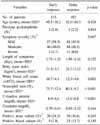Abstract
Purpose
To evaluate the values of C-reactive proteins (CRP) for predicting the severity and results of treatment for acute pyelonephritis in women, we compared the severity of symptoms and signs, the laboratory findings and the initial serum CRP according to the early response to treatment.
Materials and Methods
We retrospectively analyzed 298 female patients who were diagnosed with acute uncomplicated pyelonephritis between January 2002 and Match 2007. All the medical records were reviewed for a variety of factors, and the baseline characteristics and CRP level were compared between the patients with an early response to treatment and those without according to the 3rd hospital day urine analysis.
Results
The initial white blood cell (WBC) counts, the CRP level, the neutrophil ratio and severity of symptoms were significantly higher in the delayed response groups than those in the early response groups. The age, history of previous pyelonephritis, symptom duration, body mass index (BMI), and the number of positive blood and urine cultures were not different between the two groups. According to the results of the multivariate logistic regression analysis, the CRP level, neutrophil ratio and mild symptoms were independent predictive variables that affected the delayed response. The odds ratios (95% CI) were 1.078 (1.028-1.131) for the CRP, 1.030 (1.001-1.060) for the neutrophil ratio and 9.268 (1.072-80.166) for the severe symptoms. The differences between the areas under the ROC curves for CRP and the WBC counts and for the CRP level and neutrophil ratio were statistically significant (p<0.001 and p<0.05, respectively).
Figures and Tables
 | Fig. 1Receive operator characteristic (ROC) curve of the C-reactive protein (CRP), neutrophil ratio, and white blood cell (WBC) count for predicting pyelonephritis with a delay response. The differences between the areas under the ROC curves for the CRP level and the WBC counts and for the CRP level and the neutrophil ratio were statistically significant (p<0.001 and p<0.05, respectively), but the differences between the areas under the ROC curves for the WBC counts and the neutrophil ratio were not statistically significant (p=0.32). |
Table 1
Comparison of the clinical data, laboratory data and C-reactive protein between the early response and delay response groups

References
1. Hooton TM, Stamm WE. Diagnosis and treatment of uncomplicated urinary tract infection. Infect Dis Clin North Am. 1997. 11:551–581.
2. Foxman B, Klemstine KL, Brown PD. Acute pyelonephritis in US hospitals in 1997: hospitalization and in-hospital mortality. Ann Epidemiol. 2003. 13:144–150.
3. Elkharrat D, Chastang C, Boudiaf M, Le Corre A, Raskine L, Caulin C. Relevance in the emergency department of a decisional algorithm for outpatient care of women with acute pyelonephritis. Eur J Emerg Med. 1999. 6:15–20.
4. Pepys MB. C-reactive protein fifty years on. Lancet. 1981. 1:653–657.
5. Pepys MB, Hirschfield GM. C-reactive protein: a critical update. J Clin Invest. 2003. 111:1805–1812.
6. Fischer CL, Gill C, Forrester MG, Nakamura R. Quantitation of "acute-phase proteins" postoperatively. Value in detection and monitoring of complications. Am J Clin Pathol. 1976. 66:840–846.
7. Volanakis JE, Kaplan MH. Interaction of C-reactive protein complexes with the complement system. II. Consumption of guinea pig complement by CRP complexes: requirement for human C1q. J Immunol. 1974. 113:9–17.
8. Biggi A, Dardanelli L, Cussino P, Pomero G, Noello C, Sernia O, et al. Prognostic value of the acute DMSA scan in children with first urinary tract infection. Pediatr Nephrol. 2001. 16:800–804.
9. Pulliam PN, Attia MW, Cronan KM. C-reactive protein in febrile children 1 to 36 months of age with clinically undetectable serious bacterial infection. Pediatrics. 2001. 108:1275–1279.
10. Jodal U, Hanson LA. Sequential determination of C-reactive protein in acute childhood pyelonephritis. Acta Paediatr Scand. 1976. 65:319–322.
11. Chung H, Kin TW, Lee CH, Kim HS. Clinical significance of serum C-reactive protein in patients with acute uncomplicated pyelonephritis. Korean J Urol. 2005. 46:476–480.
12. Fihn SD, Johnson C, Roberts PL, Running K, Stamm WE. Trimethoprim-sulfamethoxazole for acute dysuria in women: a single-dose or 10-day course. A double-blind, randomized trial. Ann Intern Med. 1988. 108:350–357.
13. Chan YL, Liao HC, Tsay PK, Chang SS, Chen JC, Liaw SJ. C-reactive protein as an indicator of bacterial infection of adult patients in the emergency department. Chang Gung Med J. 2002. 25:437–445.
14. Guven H, Altintop L, Baydin A, Esen S, Aygun D, Hokelek M, et al. Diagnostic value of procalcitonin levels as an early indicator of sepsis. Am J Emerg Med. 2002. 20:202–206.
15. Gendrel D, Bohuon C. Procalcitonin as a marker of bacterial infection. Pediatr Infect Dis J. 2000. 19:679–687.
16. Hatherill M, Tibby SM, Sykes K, Turner C, Murdoch IA. Diagnostic markers of infection: comparison of procalcitonin with C reactive protein and leucocyte count. Arch Dis Child. 1999. 81:417–421.
17. Lemiale V, Renaud B, Moutereau S, N'Gako A, Salloum M, Calmettes MJ, et al. A single procalcitonin level does not predict adverse outcomes of women with pyelonephritis. Eur Urol. 2007. 51:1394–1401.
18. Hwang JS, Lee SH, Park HS. The association between C-reactive protein and obesity among Korean men. J Korean Acad Fam Med. 2003. 24:58–63.
19. Jung EJ, Kim MS, Jung EU, Kim JG, Kim KM, Jung SP. Correlations of C-reactive protein levels with obesity index and metabolic risk factors in healthy adults. J Korean Acad Fam Med. 2006. 27:620–628.
20. Safrin S, Siegel D, Black D. Pyelonephritis in adult women: inpatient versus outpatient therapy. Am J Med. 1988. 85:793–798.
21. Bach D, van den Berg-Segers A, Hubner A, van Breukelen G, Cesana M, Pletan Y. Rufloxacin once daily versus ciprofloxacin twice daily in the treatment of patients with acute uncomplicated pyelonephritis. J Urol. 1995. 154:19–24.
22. Warren JW, Abrutyn E, Hebel JR, Johnson JR, Schaeffer AJ, Stamm WE. Infectious Diseases Society of America (IDSA). Guidelines for antimicrobial treatment of uncomplicated acute bacterial cystitis and acute pyelonephritis in women. Clin Infect Dis. 1999. 29:745–758.




 PDF
PDF ePub
ePub Citation
Citation Print
Print




 XML Download
XML Download